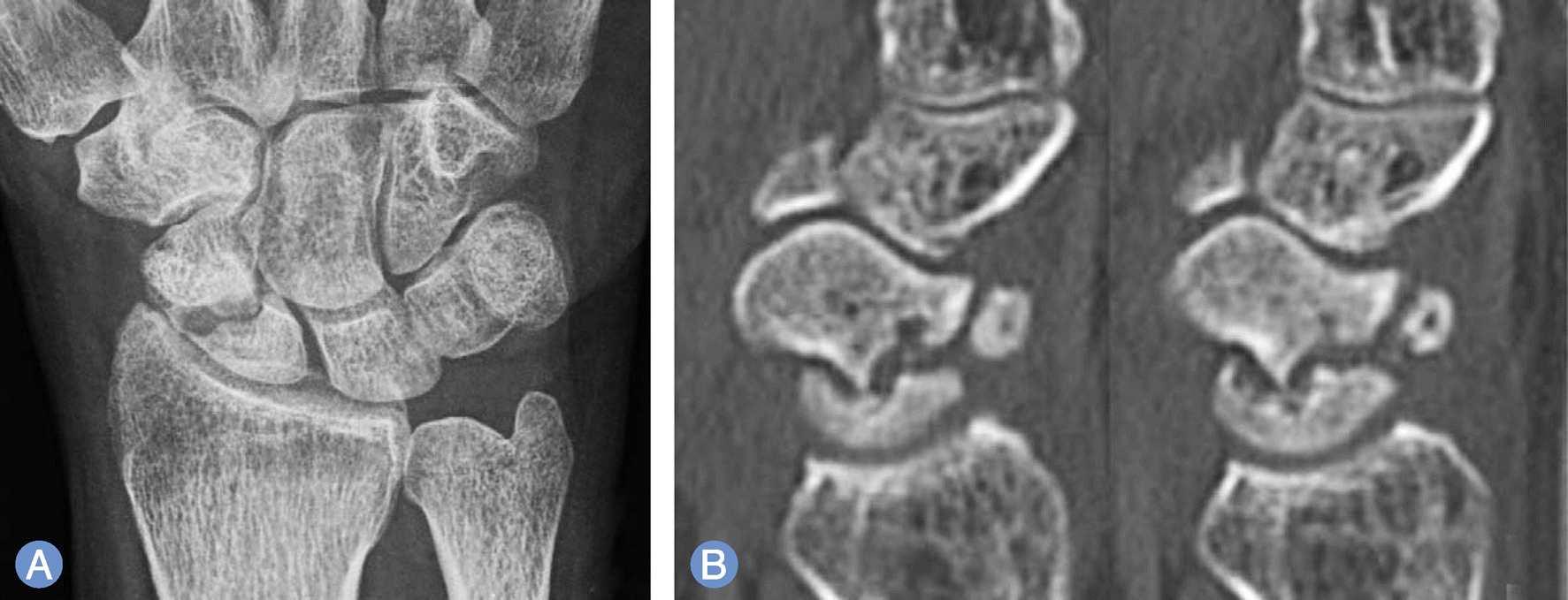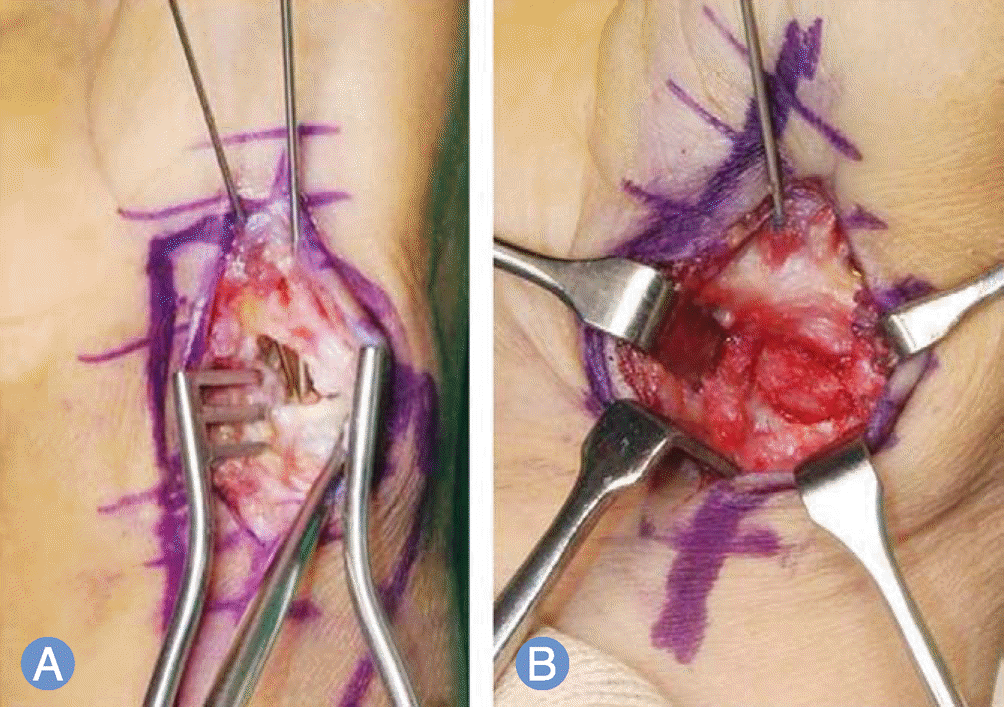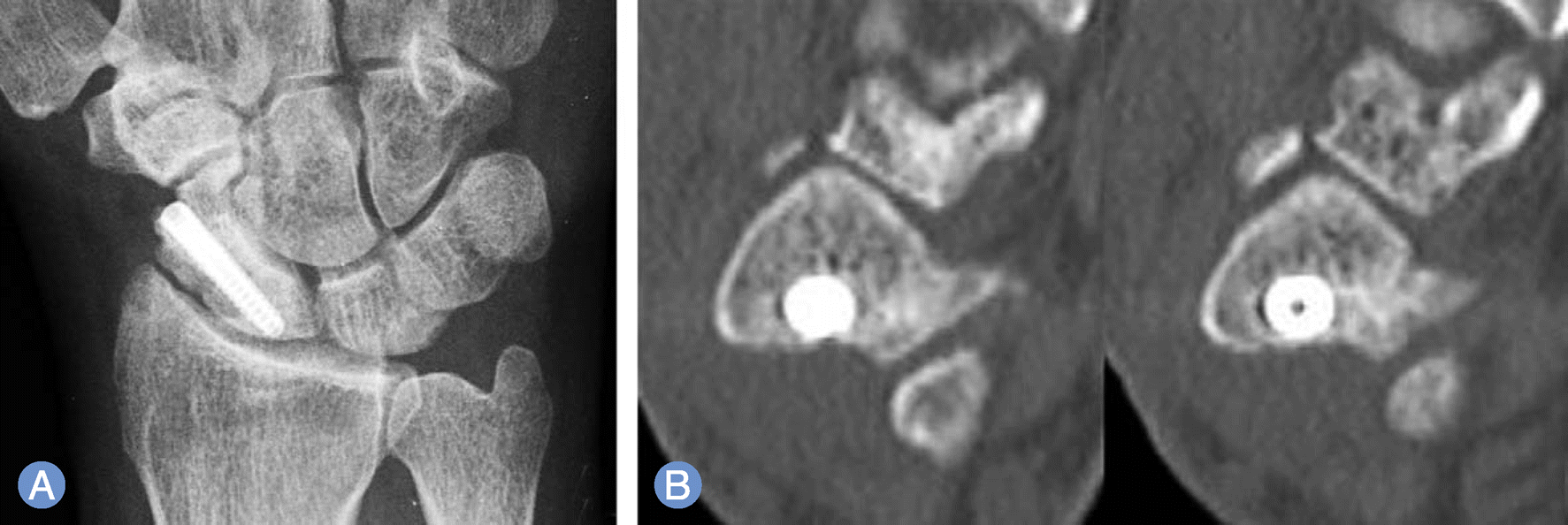Abstract
Purpose:
We evaluated clinical and radiographic results of the pure cancellous bone grafting and internal fixation for the treatment of scaphoid waist nonunions with humpback deformity.
Methods:
The subject of this study were 46 patients who had a scaphoid waist nonunion with humpback deformity treated with bone grafting between January 2005 and December 2011. The average follow-up period was 18.6 months (range, 12-26 months). We performed open reduction through an anterior approach with correction of the deformity and insertion of a screw from distal to proximal. We filled the resultant defect with pure cancellous autograft. The clinical results were evaluated with range of motion of the wrist joint, Disabilities of the Arm, Shoulder, and Hand (DASH) score, modified Mayo wrist score and visual analogue scale. For radiographic evaluation, we assessed lateral scapholunate angle and intrascaphoid angle.
Results:
Bony union was achieved in 39 out of 46 patients (84.8%). DASH score significantly improved from 24.0 to 7.3 postoperatively. The modified Mayo wrist score also increased from 64.8 to 88.6 postoperatively. There were 17 excellent results 18 good results. The average scapholunate angle and intrascaphoid angle improved from 70.6°, 51.5° to 52.4°, 33.9° postoperatively.
Go to : 
References
1. Hove LM. Epidemiology of scaphoid fractures in Bergen, Norway. Scand J Plast Reconstr Surg Hand Surg. 1999; 33:423–6.

2. Duppe H, Johnell O, Lundborg G, Karlsson M, Redlund-Johnell I. Long-term results of fracture of the scaphoid. A follow-up study of more than thirty years. J Bone Joint Surg Am. 1994; 76:249–52.
3. Dias JJ, Thompson J, Barton NJ, Gregg PJ. Suspected scaphoid fractures. The value of radiographs. J Bone Joint Surg Br. 1990; 72:98–101.

4. Cooney WP, Linscheid RL, Dobyns JH. Scaphoid fractures. Problems associated with nonunion and avascular necrosis. Orthop Clin North Am. 1984; 15:381–91.
5. Dias JJ, Brenkel IJ, Finlay DB. Patterns of union in fractures of the waist of the scaphoid. J Bone Joint Surg Br. 1989; 71:307–10.

6. Cooney WP 3rd, Dobyns JH, Linscheid RL. Nonunion of the scaphoid: analysis of the results from bone grafting. J Hand Surg Am. 1980; 5:343–54.

7. Szabo RM, Manske D. Displaced fractures of the scaphoid. Clin Orthop Relat Res. 1988; (230):30–8.

8. Buijze GA, Ochtman L, Ring D. Management of scaphoid nonunion. J Hand Surg Am. 2012; 37:1095–2002. 84:142.100.

9. Gabl M, Reinhart C, Lutz M, et al. Vascularized bone graft from the iliac crest for the treatment of nonunion of the proximal part of the scaphoid with an avascular fragment. J Bone Joint Surg Am. 1999; 81:1414–28.

10. Munk B, Larsen CF. Bone grafting the scaphoid nonunion: a systematic review of 147 publications including 5,246 cases of scaphoid nonunion. Acta Orthop Scand. 2004; 75:618–29.
11. Pao VS, Chang J. Scaphoid nonunion: diagnosis and treatment. Plast Reconstr Surg. 2003; 112:1666–76.

12. Ramamurthy C, Cutler L, Nuttall D, Simison AJ, Trail IA, Stanley JK. The factors affecting outcome after non-vascular bone grafting and internal fixation for nonunion of the scaphoid. J Bone Joint Surg Br. 2007; 89:627–32.

14. Amadio PC, Berquist TH, Smith DK, Ilstrup DM, Cooney WP 3rd, Linscheid RL. Scaphoid malunion. J Hand Surg Am. 1989; 14:679–87.

15. MacDermid JC, Richards RS, Donner A, Bellamy N, Roth JH. Responsiveness of the short form-36, disability of the arm, shoulder, and hand questionnaire, patient-rated wrist evaluation, and physical impairment measurements in evaluating recovery after a distal radius fracture. J Hand Surg Am. 2000; 25:330–40.

16. Braga-Silva J, Peruchi FM, Moschen GM, Gehlen D, Padoin AV. A comparison of the use of distal radius vascularised bone graft and non-vascularised iliac crest bone graft in the treatment of non-union of scaphoid fractures. J Hand Surg Eur Vol. 2008; 33:636–40.
17. Linscheid RL, Dobyns JH, Beabout JW, Bryan RS. Traumatic instability of the wrist: diagnosis, classification, and pathomechanics. J Bone Joint Surg Am.
18. Dias JJ. Definition of union after acute fracture and surgery for fracture nonunion of the scaphoid. J Hand Surg Br. 2001; 26:321–5.

19. Jarrett P, Kinzel V, Stoffel K. A biomechanical comparison of scaphoid fixation with bone grafting using iliac bone or distal radius bone. J Hand Surg Am. 2007; 32:1367–73.

20. Fernandez DL. A technique for anterior wedge-shaped grafts for scaphoid nonunions with carpal instability. J Hand Surg Am. 1984; 9:733–7.

21. Kawamura K, Chung KC. Treatment of scaphoid fractures and nonunions. J Hand Surg Am. 2008; 33:988–97.

22. Merrell GA, Wolfe SW, Slade JF 3rd. Treatment of scaphoid nonunions: quantitative meta-analysis of the literature. J Hand Surg Am. 2002; 27:685–91.

23. Stark HH, Rickard TA, Zemel NP, Ashworth CR. Treatment of ununited fractures of the scaphoid by iliac bone grafts and Kirschner-wire fixation. J Bone Joint Surg Am. 1988; 70:982–91.

24. Wong TC. Palmar corticocancellous grafting and Acutrak screw fixation for nonunion of the scaphoid. J Hand Surg Eur Vol. 2010; 35:421.

25. Taleisnik J, Kelly PJ. The extraosseous and intraosseous blood supply of the scaphoid bone. J Bone Joint Surg Am. 1966; 48:1125–37.

Go to : 
 | Fig. 1.
(A) Preoperative radiographs shows nonunion of scaphoid waist. (B) Computed tomography shows scaphoid nonunion and humpback deformity. |
 | Fig. 2.Intraoperatively. (A) The leading part of the pin was anchored in the center of the proximal pole with it completely across the bone graft. (B) The final axis of the pin was parallel to the volar surface of the scaphoid. |
 | Fig. 3.
(A) One year after surgery radiographs showed union of scaphoid waist fracture. (B) on computed tomography scan, humpback deformity was corrected. |
Table 1.
Clinical results




 PDF
PDF ePub
ePub Citation
Citation Print
Print


 XML Download
XML Download